The origin of the word Alamak
09/03/09 09:53 Filed in: Education
About 20
years ago, I vaguely remembered asking my mother as
well as my Malay language teacher how this word came
about. I couldn’t really get an answer to it. And I
left it at that. But now after living here in Japan, I
can’t help but asking myself the same question again!
I find this an interesting topic. I’m not a “historical linguist”. If you are and you can back me up with more facts about this, it would be a great help.
The expression “Oh my goodness!” is being said by many people in the world using different words in different languages.
In Japanese, it’s あらまあ!(pronounced: a-ra-ma-a)It doesn’t really have any literal meaning to it. Its just a word expressing an exclamation.
Interestingly, in Malay its “Alamak!”This is a word that can be broken up to mean “alah” which is a lazy tongue pronunciation of “Allah” and “Mak” which means mother. Some malay people believe “Alamak” can also mean “oh dear mother…!”
That Japanese word or expression might have been assimilated into the linguistic repertoire of the malay language or it’s the other way around! Many theories abound. And for the purpose of this post, these are just my own.
First theory:
Alamak originally comes from the Japanese.
I say “originally” because I asked one of the Japanese teachers to find out from him whether he knew that word is old or relatively new. He said that word may have been used for ages. Maybe since the Edo period (1603-1867).
Now, there has been no recorded history, of someone from the Malay Archipelago back in 1800’s or prior to that, who have ventured into Japan. Nor has there been any official representative from Japan to the Malayan Archipelago during that period. (Well the archipelago I’m mentioning here will exclude the philippines for the purpose of putting forth my theory.)
Diplomatic missions to China, yes there were. The great Sultans from Melaka (Malacca) have sent emissaries to China and also established cordial relationship with that country in order to seek protection from the bullying forces of the Siamese Kingdom.
**On a side note, what I write here is what I have learned in the history books so far. This was back in the days when Singapore students like myself were studying relevant historical knowledge of their country and the neighboring states. By “historical” I mean prior to the 1700’s. Now, I believe students are studying recent histories from 1819 onwards. Students now don’t even know anybody else in the history books apart from Sang Nila Utama and Sir Stamford Raffles. All other historical events are just being glossed over . Now students are only conscious of their history from like 50 years ago. Why is that? Why are they shortchanged? Is this part of a greater political motive?**
Back in 1942 to 1945 when the Japanese wrested control of Malaya from the British and occupied the territories of Malaya, they set up Japanese language schools. Japanese teachers teaching the Japanese language in Malaya back in those war-time might have cried “あらまあ!” in exasperation with their students. I guess that word could have been one of the (many?) Japanese words that are left as a legacy in this part of the Asian world.
Thus that supposedly Malay word “alamak” may not be that old after all!
But how can that be? I remember a long time ago hearing my grandfather saying “alamak!” when he forgot the keys to his scooter. Could he have heard it from the Japanese back then? Was it made popular by the people back then to ridicule those Japanese occupiers as they trudge back to their ships to sail back to Japan. Or could that word “Alamak” been used ever since Islam was first embraced by the Sultan in Melaka (Malacca)?
That brings me to the second theory:
あらまあ! comes from the Malays
Now this is also very interesting. Two “sub-theories” from this.
First:The Japanese occupying force in Malaya back in 1942 to 1945 quite like that word “Alamak” (maybe its catchy) so they brought that word back home to Japan after the war and used it liberally among their fellow Japanese.
Second:There were indeed sea-farers like the Orang Laut from the Malayan Archipelago who have travelled all the way to Japan during the Edo period. I presume this was possible after diplomatic missions to China were made and cordial relations were established. The Orang Laut or people from the Melaka Sultanate may have ventured towards Japan.
But could this possibly happen? As far as I know, the Japanese Shogunate had a closed door policy. During the Edo period, any foreign powers who landed on Japanese shores will be attacked, killed and completely destroyed. Maybe the Shogun made it an exception, seeing that these seafarers were unlikely to be from Europe. Also, the likelihood of the Japanese to venture out of Japan during the Edo period is close to nil because of the closed door policy. No Japanese who went abroad can come back and none from within can go out.
So that leads me to another question. What do you think?
I find this an interesting topic. I’m not a “historical linguist”. If you are and you can back me up with more facts about this, it would be a great help.
The expression “Oh my goodness!” is being said by many people in the world using different words in different languages.
In Japanese, it’s あらまあ!(pronounced: a-ra-ma-a)It doesn’t really have any literal meaning to it. Its just a word expressing an exclamation.
Interestingly, in Malay its “Alamak!”This is a word that can be broken up to mean “alah” which is a lazy tongue pronunciation of “Allah” and “Mak” which means mother. Some malay people believe “Alamak” can also mean “oh dear mother…!”
That Japanese word or expression might have been assimilated into the linguistic repertoire of the malay language or it’s the other way around! Many theories abound. And for the purpose of this post, these are just my own.
First theory:
Alamak originally comes from the Japanese.
I say “originally” because I asked one of the Japanese teachers to find out from him whether he knew that word is old or relatively new. He said that word may have been used for ages. Maybe since the Edo period (1603-1867).
Now, there has been no recorded history, of someone from the Malay Archipelago back in 1800’s or prior to that, who have ventured into Japan. Nor has there been any official representative from Japan to the Malayan Archipelago during that period. (Well the archipelago I’m mentioning here will exclude the philippines for the purpose of putting forth my theory.)
Diplomatic missions to China, yes there were. The great Sultans from Melaka (Malacca) have sent emissaries to China and also established cordial relationship with that country in order to seek protection from the bullying forces of the Siamese Kingdom.
**On a side note, what I write here is what I have learned in the history books so far. This was back in the days when Singapore students like myself were studying relevant historical knowledge of their country and the neighboring states. By “historical” I mean prior to the 1700’s. Now, I believe students are studying recent histories from 1819 onwards. Students now don’t even know anybody else in the history books apart from Sang Nila Utama and Sir Stamford Raffles. All other historical events are just being glossed over . Now students are only conscious of their history from like 50 years ago. Why is that? Why are they shortchanged? Is this part of a greater political motive?**
Back in 1942 to 1945 when the Japanese wrested control of Malaya from the British and occupied the territories of Malaya, they set up Japanese language schools. Japanese teachers teaching the Japanese language in Malaya back in those war-time might have cried “あらまあ!” in exasperation with their students. I guess that word could have been one of the (many?) Japanese words that are left as a legacy in this part of the Asian world.
Thus that supposedly Malay word “alamak” may not be that old after all!
But how can that be? I remember a long time ago hearing my grandfather saying “alamak!” when he forgot the keys to his scooter. Could he have heard it from the Japanese back then? Was it made popular by the people back then to ridicule those Japanese occupiers as they trudge back to their ships to sail back to Japan. Or could that word “Alamak” been used ever since Islam was first embraced by the Sultan in Melaka (Malacca)?
That brings me to the second theory:
あらまあ! comes from the Malays
Now this is also very interesting. Two “sub-theories” from this.
First:The Japanese occupying force in Malaya back in 1942 to 1945 quite like that word “Alamak” (maybe its catchy) so they brought that word back home to Japan after the war and used it liberally among their fellow Japanese.
Second:There were indeed sea-farers like the Orang Laut from the Malayan Archipelago who have travelled all the way to Japan during the Edo period. I presume this was possible after diplomatic missions to China were made and cordial relations were established. The Orang Laut or people from the Melaka Sultanate may have ventured towards Japan.
But could this possibly happen? As far as I know, the Japanese Shogunate had a closed door policy. During the Edo period, any foreign powers who landed on Japanese shores will be attacked, killed and completely destroyed. Maybe the Shogun made it an exception, seeing that these seafarers were unlikely to be from Europe. Also, the likelihood of the Japanese to venture out of Japan during the Edo period is close to nil because of the closed door policy. No Japanese who went abroad can come back and none from within can go out.
So that leads me to another question. What do you think?
|
Foreign language assimilated into Japanese Language
02/03/09 09:53 Filed in: Education
Its common
knowledge that Japanese use quite a lot of words
derived from the English language into their daily
lives. For example:
Frying pan = Furainggu panTaiya = Tyre
and others.
But English words are not the only ones that have been “Japanised” if I may say that.
Take for example the word for bread in Japanese is パン pronounced ”Pahn”.
Only today did I realize this word is a foreign word. Well I should have picked up the clue because it’s written in katakana and not hiragana like so: ぱん
Anything that’s written using the Katakana meant the word is foreign based.
Well I thought it was an original Japanese word because it doesn’t even sound like bread to me!
Well guess what, I remembered that the French word for bread is pain, pronounced as “pahn” (something closer to that)!
Well here’s another:
Clown = ピエロ pronounced “pi-e-ro”
Well pi-e-ro sounds like Pierrot, a french clown!
Alamak! (a supposedly malay exclamation word) = あらまあ!(This is could actually be a Japanese word being assimilated into the Malay language or the other way around. read my theories here.)
I’ll update this post as and when I come across or remember more words.
Frying pan = Furainggu panTaiya = Tyre
and others.
But English words are not the only ones that have been “Japanised” if I may say that.
Take for example the word for bread in Japanese is パン pronounced ”Pahn”.
Only today did I realize this word is a foreign word. Well I should have picked up the clue because it’s written in katakana and not hiragana like so: ぱん
Anything that’s written using the Katakana meant the word is foreign based.
Well I thought it was an original Japanese word because it doesn’t even sound like bread to me!
Well guess what, I remembered that the French word for bread is pain, pronounced as “pahn” (something closer to that)!
Well here’s another:
Clown = ピエロ pronounced “pi-e-ro”
Well pi-e-ro sounds like Pierrot, a french clown!
Alamak! (a supposedly malay exclamation word) = あらまあ!(This is could actually be a Japanese word being assimilated into the Malay language or the other way around. read my theories here.)
I’ll update this post as and when I come across or remember more words.
Niseko Snowboarding in the snow storm!
01/03/09 09:52 Filed in: JET
A friend
just outsourced a design job to me and I have to get it
done by Monday. Very rushed indeed.
I need a break! So here’s an update to the latest and LAST snowboarding trip for this year. We went to Niseko.
I want to learn skiing next winter. We’ll see how that goes.
Once the snow clears, I’m going cross-island cycling! But maybe not so soon, probably in summer when the weather is much warmer. People here say spring time here in Hokkaido is cold! Guess its really hard to shrug off the bitter winter cold.
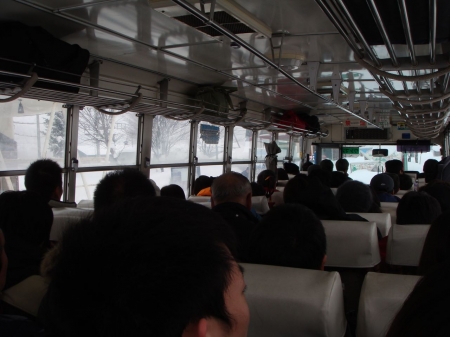
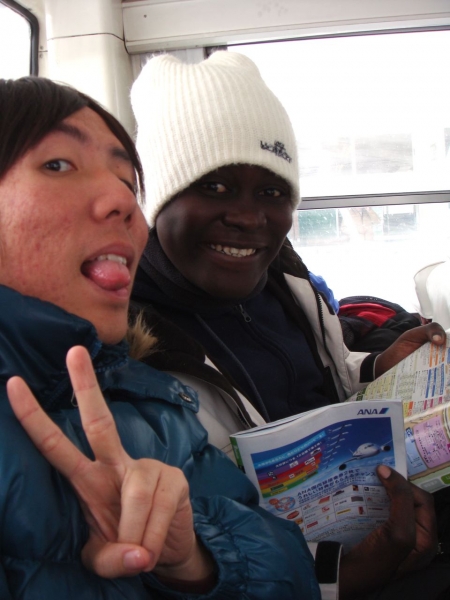
In the bus at Kutchan. On the way to Niseko.
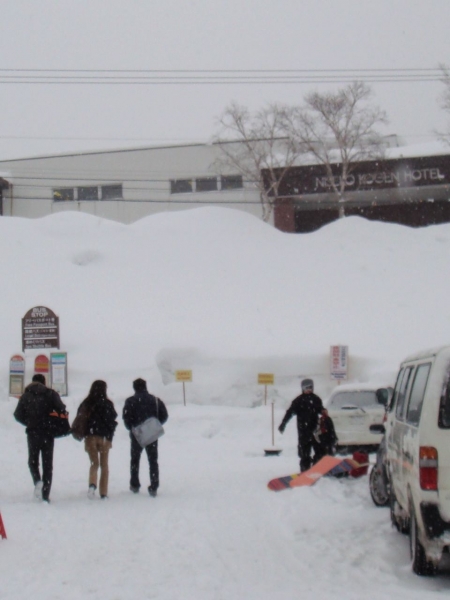
And we’re here.
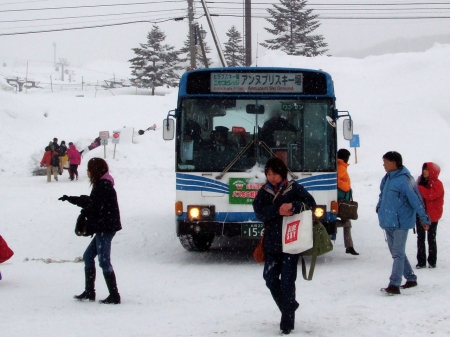
I must say I prefer Kiroro to Niseko. Kiroro looks more spiffy and upmarket.
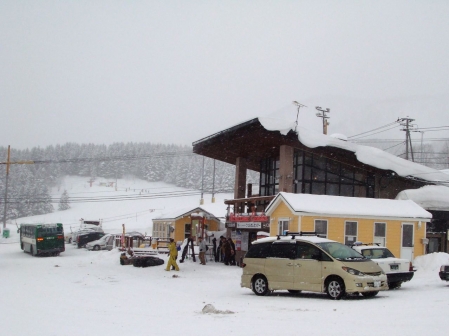
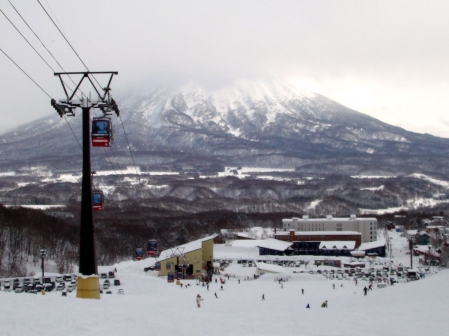
The view from up the mountain. Not really that high, but the view here is amazing.
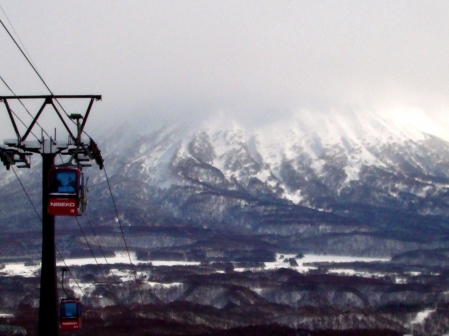
Here’s a closer look!
We went carving the snow covered slope for about an hour and a half. It was a “warm up” at the low beginner’s slope. Was really hungry after that.
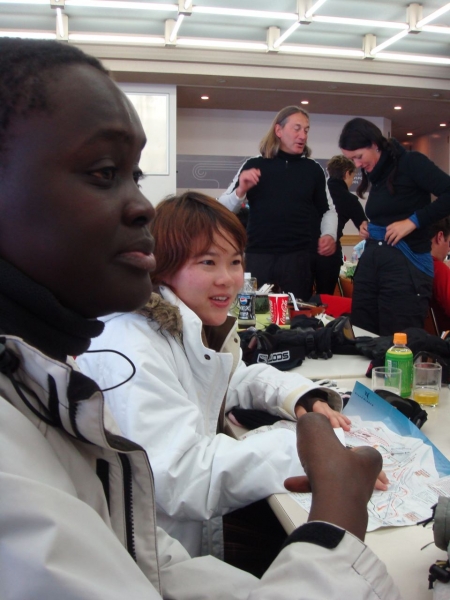
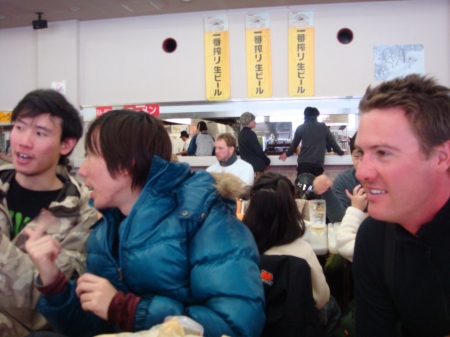
We’re not allowed to bring food from outside the food court to eat here. But we did it anyway.
After lunch we decided to head up to the top of the mountain! Well almost.
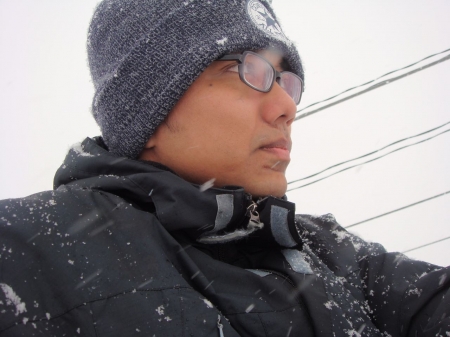
It was snowing heavily.
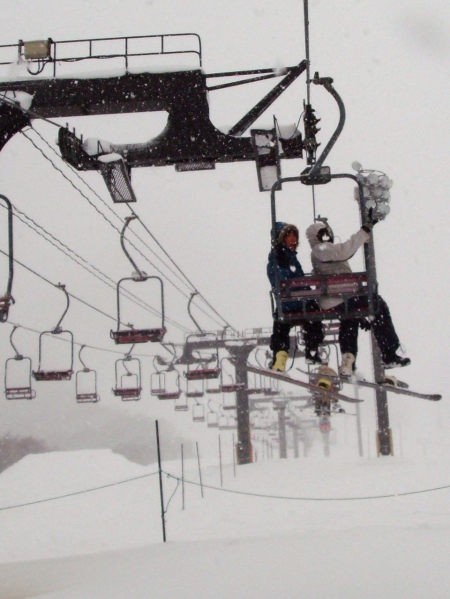
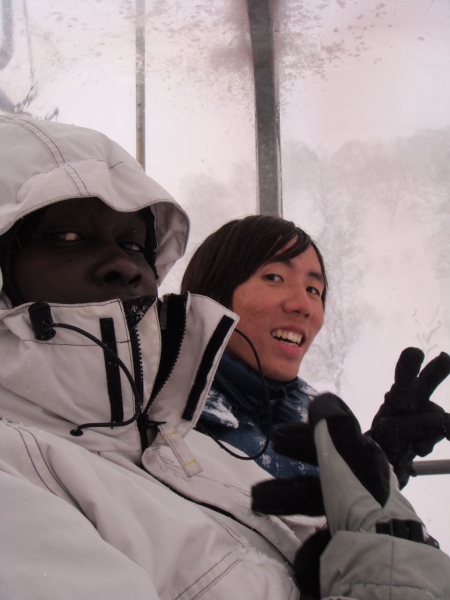
We took several other ski lifts to get to the top of the mountain. Here’s us inside the covered ski lift. Its covered with a movable canopy because we’re almost near the top of the mountain. It was very, very windy. At one point the ride stopped and was hanging on the line because of the strong winds.
Once we got off the lift, the “adventure” began!
We strapped our feet to the board. Oh I have to mention the snow was really powdery. We slid down about 5 meters when a huge gust came at us. All that snow blowing into my face made it impossible to see anything. Everything was white.
I kept falling backwards, blown by the wind!
The group went ahead with much difficulty. All I could see in front of me was plain white. It was white everywhere. And it was extremely cold. I could not even fish out my camera from my zip pocket near my chest to capture the moment.
Icicles form on my eyelashes. The wind kept on blowing, delivering blasts of snow on us. We could not move. All of us could only sit and curl ourselves up, waiting for the snow to pass.
Then the wind stopped. Briefly. Then it started again! More powder on our faces. The gust of wind kept on its intermittent act the whole time.
I unstrapped my board. I could not slide anymore. I ran towards the group. They were waiting. It was really difficult to walk in that much soft powdery snow.
I think most of us were thinking we should hurry on down the mountain where it is not as tormentingly frigid and windy. Once the wind stopped I strapped back on and we quickly carved the snowy slopes downwards.
It was unbelievable, we were lucky to get down alive! Hah!
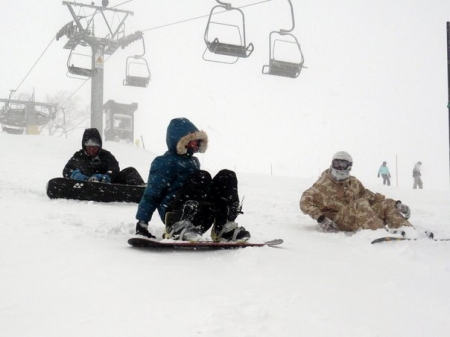
Taking a break.
This was somewhere near the halfway mark down the mountain. Most of the time my legs got frozen stiff due to muscle cramps. I was constantly in half-squat position while negotiating the terrain. Tumbling down most of the time because my legs couldn’t take it. It feels like I’m in a constant state of muscular tetanus!
Maybe it was because I didn’t do much stretching beforehand. Maybe it was the bitter cold. Maybe it was just because It has been a long time since I have done much exercise!
But it was one heck of a ride.
Falling and tumbling down felt really good. It was really fun too because the soft powdery snow helped cushion my fall. Glad I didn’t hit my head hard like I did before in Kiroro. Up here there are less people sifting through the snow. In Kiroro, the snow becomes compacted. It makes falling a real pain.
Strangely, Japanese people don’t wear helmets. Its available for rent but almost no one wears one.
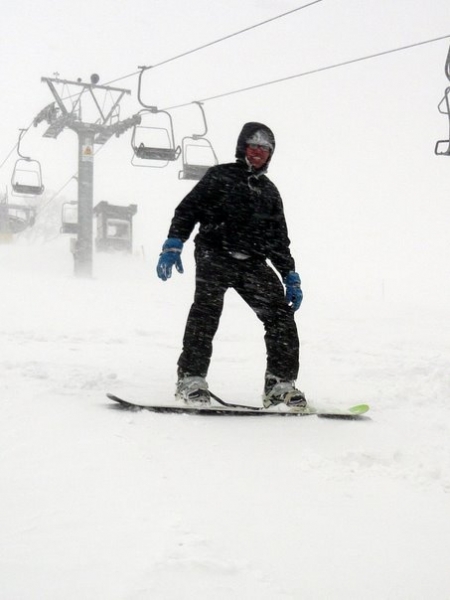
Photo Courtesy of Adeline.
As you can see from the photo above the windy was really crazy. It was worse when we first started up near the top.
Well, that ends my snowboarding adventure for this year.
On retrospect, it was really crazy for us to be in Niseko at that time. The weather forecasted for that week was a snowstorm! To top it off, the day after I was back from Niseko, Ice told me over the phone that there was Japan issued a nation-wide avalanche alert about a week ago.
Wow. We were lucky indeed.
That reminded me. There was a photo pasted around in Niseko about an Australian who went missing. Hope he’s found. Else they’ll have to wait till summer time.
Next year, Ski!
I need a break! So here’s an update to the latest and LAST snowboarding trip for this year. We went to Niseko.
I want to learn skiing next winter. We’ll see how that goes.
Once the snow clears, I’m going cross-island cycling! But maybe not so soon, probably in summer when the weather is much warmer. People here say spring time here in Hokkaido is cold! Guess its really hard to shrug off the bitter winter cold.


In the bus at Kutchan. On the way to Niseko.

And we’re here.

I must say I prefer Kiroro to Niseko. Kiroro looks more spiffy and upmarket.


The view from up the mountain. Not really that high, but the view here is amazing.

Here’s a closer look!
We went carving the snow covered slope for about an hour and a half. It was a “warm up” at the low beginner’s slope. Was really hungry after that.


We’re not allowed to bring food from outside the food court to eat here. But we did it anyway.
After lunch we decided to head up to the top of the mountain! Well almost.

It was snowing heavily.


We took several other ski lifts to get to the top of the mountain. Here’s us inside the covered ski lift. Its covered with a movable canopy because we’re almost near the top of the mountain. It was very, very windy. At one point the ride stopped and was hanging on the line because of the strong winds.
Once we got off the lift, the “adventure” began!
We strapped our feet to the board. Oh I have to mention the snow was really powdery. We slid down about 5 meters when a huge gust came at us. All that snow blowing into my face made it impossible to see anything. Everything was white.
I kept falling backwards, blown by the wind!
The group went ahead with much difficulty. All I could see in front of me was plain white. It was white everywhere. And it was extremely cold. I could not even fish out my camera from my zip pocket near my chest to capture the moment.
Icicles form on my eyelashes. The wind kept on blowing, delivering blasts of snow on us. We could not move. All of us could only sit and curl ourselves up, waiting for the snow to pass.
Then the wind stopped. Briefly. Then it started again! More powder on our faces. The gust of wind kept on its intermittent act the whole time.
I unstrapped my board. I could not slide anymore. I ran towards the group. They were waiting. It was really difficult to walk in that much soft powdery snow.
I think most of us were thinking we should hurry on down the mountain where it is not as tormentingly frigid and windy. Once the wind stopped I strapped back on and we quickly carved the snowy slopes downwards.
It was unbelievable, we were lucky to get down alive! Hah!

Taking a break.
This was somewhere near the halfway mark down the mountain. Most of the time my legs got frozen stiff due to muscle cramps. I was constantly in half-squat position while negotiating the terrain. Tumbling down most of the time because my legs couldn’t take it. It feels like I’m in a constant state of muscular tetanus!
Maybe it was because I didn’t do much stretching beforehand. Maybe it was the bitter cold. Maybe it was just because It has been a long time since I have done much exercise!
But it was one heck of a ride.
Falling and tumbling down felt really good. It was really fun too because the soft powdery snow helped cushion my fall. Glad I didn’t hit my head hard like I did before in Kiroro. Up here there are less people sifting through the snow. In Kiroro, the snow becomes compacted. It makes falling a real pain.
Strangely, Japanese people don’t wear helmets. Its available for rent but almost no one wears one.

Photo Courtesy of Adeline.
As you can see from the photo above the windy was really crazy. It was worse when we first started up near the top.
Well, that ends my snowboarding adventure for this year.
On retrospect, it was really crazy for us to be in Niseko at that time. The weather forecasted for that week was a snowstorm! To top it off, the day after I was back from Niseko, Ice told me over the phone that there was Japan issued a nation-wide avalanche alert about a week ago.
Wow. We were lucky indeed.
That reminded me. There was a photo pasted around in Niseko about an Australian who went missing. Hope he’s found. Else they’ll have to wait till summer time.
Next year, Ski!